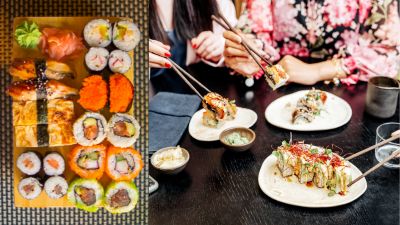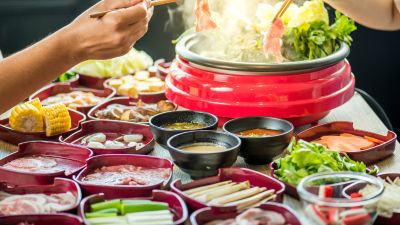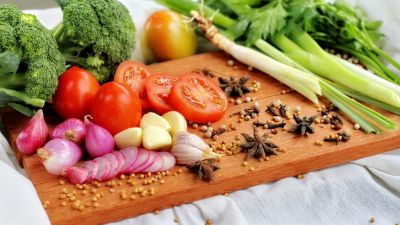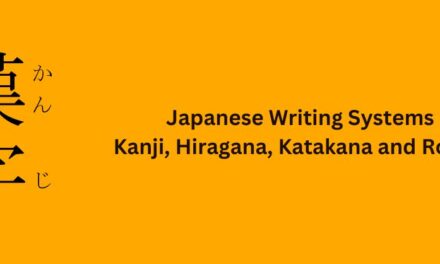Talking About Food in Japanese: Key Vocabulary and Phrases
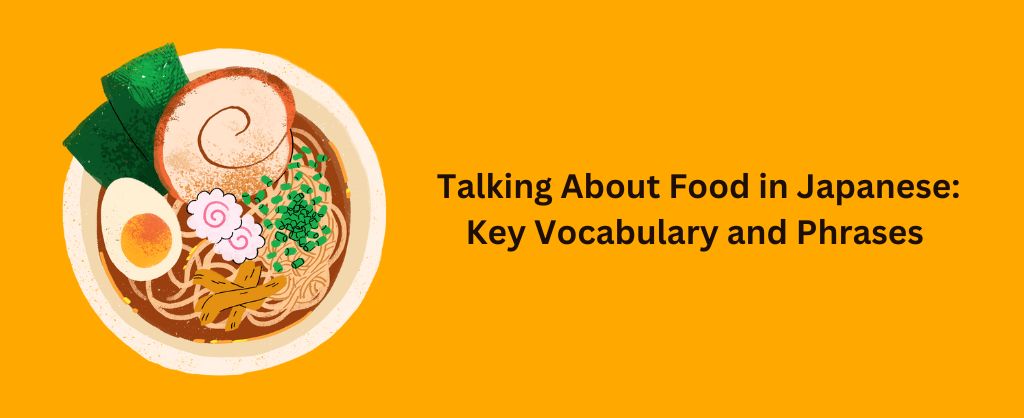
Register For the Online Japanese Event
Whether you’re dining out in Japan or trying to cook Japanese food yourself, knowing food vocabulary and phrases will help you have a more enjoyable experience.
In this guide, we’ll cover everything from restaurant etiquette to cooking terminology to ingredient names. With the help of this article, you’ll be well on your way to discussing food fluently in Japanese!
Content
- Japanese Food Vocabulary
- Ordering Food and Drinks
- Useful Restaurant Words and Phrases
- Types of Japanese Cuisine
- Cooking Terminology and Essential Ingredients
- Sample Japanese Recipes
- Talking About Food Experiences in Japanese
- Important Phrases for the Conversation
- Tips for Learning Japanese Food Vocabulary
Japanese Food Vocabulary
Japanese cuisine (日本料理 – Nihon ryōri) is known for its delicate flavors, beautiful presentation, and use of fresh seasonal ingredients. Japanese cuisine focuses on simplicity, minimalism and enhancing the flavors of fresh seasonal ingredients.
Some basic food words and phrases:
- Gohan (ごはん) – Cooked rice or meal
- Meshī (めし) – Another word for meal or cooked rice
- Pan (パン) – Bread
- Ocha (お茶) – Tea
- Mizu (水) – Water
- Nihonshu (日本酒) – Sake (Japanese rice wine)
- Oishii (美味しい) – Delicious
- Oishikunai (美味しくない) – Not delicious
- Gochisōsama (deshita) (ごちそうさま(でした)) – Thanks for the meal
- Itadakimasu (頂きます) – Let’s eat/I humbly receive this food
- Gochisō o nuirishimashita (ご馳走をぬいりしました) – Thank you for the delicious meal
Ordering Food and Drinks
When you’re ready to order at a restaurant or cafe, here are some key phrases to know:
- Sumimasen, chotto… (すみません、ちょっと・・・) – Excuse me, could I please…
- Ramen o hitotsu onegaishimasu (ラーメンを1つお願いします) – One ramen please
- Biiru hitotsu onegaishimasu (ビール1つお願いします ) – One beer please
- Ocha o hitotsu kudasai (お茶を1つください) – One tea please
- Gochisō sama deshita (ごちそうさまでした) – Thank you for the meal
Useful Restaurant Words and Phrases
When dining in Japan, these words and expressions will come in handy:
- Mise (店) – Restaurant, shop
- Irasshaimase! (いらっしゃいませ!) – Welcome! (said by staff when entering a restaurant)
- Nanmei sama deshou ka? (何名様でしょうか?) – How many people? (when being seated)
- Smoking/non-smoking? – Kitsuen wa daijōbu desu ka? (喫煙は大丈夫ですか?), Kin’en wa daijōbu desu ka? (禁煙は大丈夫ですか?)
- Sumimasen, oshibori o kudasai. (すみません、おしぼりをください。) – Excuse me, could I have a hot towel please?
- O-mizu o kudasai. (お水をください。) – Water please.
- Gohan o kudasai. (ご飯をください。) – Rice, please.
- O-kan o kudasai. (お勘定をください。) – Check please.
Types of Japanese Cuisine
From sushi to ramen, here are some of the most popular types of Japanese food:
- Sushi (寿司) – Raw fish, seafood, and vegetables served on vinegar rice. Types include nigiri-zushi (握り寿司) and maki-zushi (巻き寿司).
- Sashimi (刺身) – Sliced raw seafood, often served with soy sauce and wasabi.
- Tempura (天ぷら) – Seafood and vegetables deep fried in a light batter.
- Ramen (ラーメン) – Noodles in broth, often with meat and vegetables. Popular types include shoyu (soy sauce), shio (salt), miso, and tonkotsu (pork bone broth) ramen.
- Donburi (丼ぶり) – Meat, seafood, and/or vegetables served over rice in a bowl. Examples are katsudon (pork cutlet), gyudon (beef and onion), and oyakodon (chicken and egg).
- Yakitori (焼き鳥) – Skewers of grilled chicken.
- Yakiniku (焼肉) – Japanese style barbecue, often self-cooked at the table.
- Kaiseki (懐石) – Multi-course traditional Japanese meal.
Cooking Terminology
Moving on to the kitchen, here are some key Japanese words related to cooking:
- Ryōri (料理) – Cuisine, cooking
- Ajikau (味加減) – Flavor, taste
- Ajiwai (味わい) – Flavor, taste
- Nimono (煮物) – Simmered/boiled dish
- Itameru (炒める) – Stir frying
- Yakimono (焼き物) – Grilled dish
- Agemono (揚げ物) – Fried food
- Niramu (煮る) – To boil
- Furū (振るう) – To shake (usually in a pan)
- Makikomu (巻き込む) – To mix in
- Karameru (絡める) -To stir together
- Awasekōji (淡色味噌) – Light brown miso
- Kuro goma (黒胡麻) – Black sesame seeds
Essential Ingredients
Now let’s go over some key ingredients used in Japanese cooking:
- Rice (米 – kome) – The staple ingredient in Japanese cuisine. Types include white rice, brown rice, sticky rice (mochi gome).
- Noodles (麺類 – menrui) – Ramen noodles, udon noodles, soba noodles. Can be served hot or cold.
- Seafood (魚 – sakana) – Including salmon (sake), tuna (maguro), mackerel (saba), shrimp (ebi), squid (ika), etc.
- Meat (肉 – niku) – Most often chicken (toriniku) and pork (butaniku), sometimes beef (gyuniku).
- Tofu (豆腐 – tōfu) – Bean curd, comes in soft ( kinugoshi), firm (momen), and fried (abura-age) varieties.
- Vegetables (野菜 – yasai) – Such as cucumber (kyūri), eggplant (nasu), shiitake mushrooms (shiitake), green onion (negi), daikon radish (daikon), etc.
- Fruits (果物 – kudamono) – Strawberries (ichigo), melons (meron), grapes (budō), and citrus fruits (kan kitsu) are common.
- Seasonings – Soy sauce (shōyu), miso paste (miso), mirin rice wine, dashi stock, sake, rice vinegar (komezu), sesame oil (goma abura), wasabi, ginger (shōga), and more.
Sample Japanese Recipes
Here are a few classic recipes with key ingredients and instructions in Japanese:
Miso Soup (味噌汁 – Misoshiru)
Ingredients:
- Dashi stock – 1 cup (一杯)
- Miso paste – 3 tbsp (大さじ3)
- Tofu – 100g (100グラム)
- Wakame seaweed – 2 tbsp (大さじ2)
- Green onion – 1 stalk, chopped (小ねぎ一本)
Instructions:
- Dashi to nirashite kudasai. (だしを煮立ててください。) Bring dashi stock to a boil.
- Miso to makikonde kudasai. (味噌を混ぜ込んでください。) Mix in miso paste.
- Tōfu to wakame o irete kudasai. (豆腐とわかめを入れてください。) Add tofu and wakame.
- Negī o furuide kudasai. (ねぎを振り入れてください。) Garnish with green onions.
Yakitori (焼き鳥)
Ingredients:
- Chicken thigh – 100g (もも肉100グラム)
- Shōyu – 2 tbsp (醤油大さじ2)
- Mirin – 1 tbsp (みりん大さじ1)
- Sake – 1 tbsp (酒大さじ1)
Instructions:
- Toriniku ni shōyu, mirin, sake o makikomu. (鶏肉に醤油、みりん、酒を混ぜ込む。) Mix chicken with soy sauce, mirin, and sake. Marinate for 30 minutes.
- Bin ga niramu made yakitori o yaku. (燃えが煮らむまで焼き鳥を焼く。) Grill yakitori until coals are hot and chicken is cook through.
- Yakitori o ketchup de migaitara kansei. (焼き鳥をケチャップで磨いたら完成。) When chicken is cooked, brush with ketchup to finish.
Tamagoyaki (卵焼き) Sweet Egg Omelette
Ingredients:
- Eggs – 2
- Dashi stock – 1 tbsp (大さじ1)
- Soy sauce – 1 tsp (小さじ1)
- Mirin – 1 tbsp (大さじ1)
- Sugar – 1/2 tsp (小さじ1/2)
- Oil – For frying (少々)
Instructions:
- Tamago ni dashi, shōyu, mirin, satō o makikomu. (卵に出汁、醤油、みりん、砂糖を混ぜ込む。) Beat eggs together with dashi, soy sauce, mirin and sugar.
- Abura o teppan ni furu. (油を鉄板に塗る。) Heat oil in pan.
- Tamagoyaki o asaichi ni yaki, makikogasete mawashite yaku. (卵焼きを浅いちに焼き、混ぜこがせて回して焼く。) Cook a thin layer of egg, then roll up and continue cooking.
- Sukoshi yudaneba kansei. (少し冷やせば完成。) Let cool slightly and serve.
Talking About Food Experiences in Japanese
Now that you know some key food words and phrases, here are some examples of talking about dining experiences in Japanese:
- Talking about a restaurant you visited:
Kinō ABC resutoran ni itta. Shokutaku wa atarashī mise de, interia ga totemo kirei datta. Bīru to edamame o tanonda. Yakitori moriawase to misoshiru o tabeta. Tabemono wa totemo oishikatta. Mata ikitaī mise desu.
昨日ABCレストランに行った。食卓は新しい店で、インテリアがとてもきれいだった。ビールと枝豆を頼んだ。焼き鳥盛り合わせと味噌汁を食べた。食べ物はとても美味しかった。また行きたいお店です。
Yesterday I went to ABC Restaurant. It was a new restaurant and the interior was very beautiful. I ordered beer and edamame. I ate yakitori platter and miso soup. The food was very delicious. It’s a restaurant I want to go to again.
- Describing a home cooked meal:
Kyō wa ie de kare raisu to tsukemono o tsukutta. Niku to tamanegi to jagaimo o kare ni ireta. Oishikatta shi, raishuu mo tsukuri-tai desu. Supein kara okurareta gurin pīnzu no nukazuke o tabeta. Aji ga totemo umaremashita.
今日は家でカレーライスと漬物を作った。肉とタマネギとじゃが芋をカレーに入れた。美味しかったし、来週も作りたいです。スペインから送られたグリーンピーンズの浅漬けを食べた。味がとてもうまれました。
Today I cooked curry rice and pickles at home. I put meat, onion, and potatoes in the curry. It was delicious and I want to make it again next week. I ate pickled green beans sent from Spain. The flavor was really delicious.
- Discussing preferences:
Watashi no suki na ryōri wa itaria ryōri desu. Pasta ya piza ga daisuki desu. Nihon ryōri no naka de wa, sushi to ramen ga ichiban suki desu. Anoko wa furansu ryōri ga ichiban suki dattari suru. Furan su pan to keeki, suramē ya harosetto ga tokui da sō desu.
私の好きな料理はイタリア料理です。パスタやピザが大好きです。日本料理の中では、寿司とラーメンが一番好きです。あの子はフランス料理が一番好きだったりする。フランスパンとケーキ、クレームブリュレやハロセットが得意だそうです。
My favorite cuisine is Italian. I love pasta and pizza. Within Japanese food, sushi and ramen are my favorites. That girl seems to like French cuisine the most. She is good at making French bread and cakes, creme brulee and choux pastry.
Important Phrases for the Conversation
一番好きなレシピを紹介してください。- Ichiban suki na reshipi o shoukai shite kudasai. – Please share your favorite recipe
普段料理をしますか?- Fudan ryouri o shimasuka? – Do you usually cook?
好き嫌いはありますか? – Suki kirai wa arimasuka? – Are you picky about food?
人生で一番美味しかった食べ物は何ですか? – Jinsei de ichiban oishikatta tabemono wa nandesuka? – What was the best food you’ve ever eaten in your life?
毎日三食食べますか? – Mainichi san shoku tabemasuka? – Do you eat three meals a day?
食べられない食べ物はありますか?- Taberarenai tabemono wa arimasuka? – Do you have any foods you can’t eat?
一番嫌いな食べ物は何ですか?- Ichiban kirai na tabemono wa nandesuka? – What’s your least favorite food?
一番好きな食べ物は何ですか? – Ichiban suki na tabemono wa nandesuka? – What’s your favorite food?
料理上手ですか? – Ryouri jouzu desuka? – Are you good at cooking?
今日は何を食べましたか? – Kyou wa nani o tabemashita ka? – What did you eat today?
普段どんな食べ物を食べますか?- Fudan donna tabemono o tabemasuka? – What kinds of food do you usually eat?
近くに良いレストランはありますか?- Chikaku ni ii resutoran wa arimasuka? – Are there nice restaurants nearby?
どんな面白い食べ物を食べたことがありますか?- Donna omoshiroi tabemono o tabeta koto ga arimasuka? – What kinds of interesting foods have you eaten?
日本食は好きですか? – Nihon shoku wa suki desuka? – Do you like Japanese food?
If yes: 一番好きな日本の食べ物は何ですか?- Ichiban suki na nihon no tabemono wa nan desu ka? – What is your favorite Japanese dish?
辛い物と甘い物とどっちが好きですか?- Karai mono to amai mono to docchi ga suki desuka? – Do you prefer spicy food or sweet food?
さんの国を代表する食べ物は何ですか? – san no kuni o daihyou suru tabemono wa nandesuka? – What food do you think represents your country?
More Vocabulary:
- 料理 – ryouri – cooking or dish
- 食べ物 – tabemono – food
- レシピ – reshipi – recipe
- ベジタリアン – bejitarian – vegetarian
- ビーガン – biigan – vegan
- アレルギー – arerugii – allergy
- グルテンフリー – guruten furii – gluten free
Tips for Learning Japanese Food Vocabulary
Here are some final tips to help you practice your food vocabulary and have better dining experiences in Japan:
- Label items in your kitchen with sticky notes or flashcards of the Japanese words.
- Pay attention to food vocabulary when watching Japanese TV shows or anime about cooking.
- Order in Japanese when dining at an izakaya restaurant or sushi train.
- Go grocery shopping and look for familiar foods or ingredients you learned.
- Cook a Japanese recipe while practicing the cooking terms. Have a language exchange partner taste test!
- Follow Japanese food personalities on social media and note any new words.
- Sign up for a cooking class taught in Japanese.
With consistent study and immersion, you’ll be discussing food, ordering meals, and whipping up Japanese dishes in no time.

